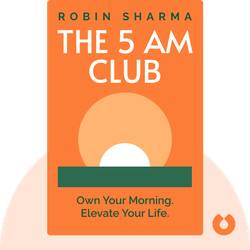Try Blinkist to get the key ideas from 7,000+ bestselling nonfiction titles and podcasts. Listen or read in just 15 minutes.
Start your free trial
Blink 3 of 8 - The 5 AM Club
by Robin Sharma

A History
'Heart' by Sandeep Jauhar is a personal and informative exploration of the human heart. It delves into heart disease, medical technology, and the author’s own experiences as a cardiologist and sufferer of heart disease.
Children love exploring the world around them and figuring out how it works. The author, Sandeep Jauhar, was no different. As a teenager, he once decided that for a school science project he would measure the electrical signals emanating from a frog’s heart. To do this, he’d have to dissect one. Unfortunately, all he ended up doing was causing the frog a tremendous amount of pain.
It was at that moment the Jauhar’s mother found him, weeping at what he’d done to the poor creature.
She tenderly explained to him that his heart was too small to take on a task that required such developed empathy: a small heart wouldn’t yet be courageous enough.
Jauhar’s mother was tapping into a well-worn metaphor, but that doesn’t make it any less potent – for centuries the heart has been associated with feelings such as courage.
It was in Renaissance Europe that the heart first began to be seen as the seat of human courage. Consequently, depictions of hearts found their way onto coats of arms as symbols of loyalty and bravery. The very word “courage” is derived from the Latin word for heart, “cor.”
The logical consequence of this metaphor is that people with small hearts lack courage and strength. This might result in them admitting defeat early on when beginning difficult tasks.
Interestingly, this metaphor stretches much further than the cultures of Europe. Take Jauhar’s grandmother as an example. She used to regularly chastise her family, telling them to "take heart” when she felt they were about to give up on a venture.
Most famously, of course, the heart is a metaphor for love. It’s been that way since the Middle Ages. In fact, the connection between heart and love is so strong that if you ask people what image they associate most with love, they’ll likely visualize a valentine heart.
There’s even a scientific name for this shape. It’s called a cardioid, and you see it everywhere in nature – certain leaves, flowers and seeds all occur as cardioids.
One such example is the silphium plant. Its heart-shaped seeds were used throughout the Middle Ages as a natural contraceptive.
It may be because of this usage that this particular heart shape became so linked with courtship and sexual behavior.
The heart shape found its way into courtship paintings of the era and, from then on, the cardioid heart has become the symbol of romance in the West.



Heart (2018) examines an organ that has baffled humanity for centuries. By delving into the history of the heart, both from a biological and a cultural perspective, it explains why the heart plays such an important role in human history.
Heart (2018) is a captivating exploration of our most vital organ and its impact on our lives. Here's why this book is worth reading:
Today we know that emotions do not reside in the heart per se, but we nevertheless continue to subscribe to the hearts symbolic connotations.

It's highly addictive to get core insights on personally relevant topics without repetition or triviality. Added to that the apps ability to suggest kindred interests opens up a foundation of knowledge.
Great app. Good selection of book summaries you can read or listen to while commuting. Instead of scrolling through your social media news feed, this is a much better way to spend your spare time in my opinion.
Life changing. The concept of being able to grasp a book's main point in such a short time truly opens multiple opportunities to grow every area of your life at a faster rate.
Great app. Addicting. Perfect for wait times, morning coffee, evening before bed. Extremely well written, thorough, easy to use.
Try Blinkist to get the key ideas from 7,000+ bestselling nonfiction titles and podcasts. Listen or read in just 15 minutes.
Start your free trial
Blink 3 of 8 - The 5 AM Club
by Robin Sharma
What is the main message of Heart?
The main message of Heart is the importance and complexity of the human heart.
How long does it take to read Heart?
The reading time for Heart varies depending on the reader's speed, but it typically takes several hours. However, the Blinkist summary can be read in just 15 minutes.
Is Heart a good book? Is it worth reading?
Heart is a thought-provoking and insightful book worth reading. It explores the medical and emotional aspects of the heart in an engaging way.
Who is the author of Heart?
The author of Heart is Sandeep Jauhar.